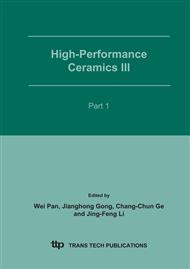p.353
p.357
p.361
p.365
p.369
p.373
p.377
p.381
p.385
Impedance Analysis Study on the Sensing Process of BaTiO3 Based PTC Ceramics in CO Gas
Abstract:
Impedance spectroscopy is suitable to evaluate the electric structure and behavior by probing the relaxational processes during the charge transport within this kind of electrically inhomogeneous PTCR ceramics. This technique has been used to characterize the change of structure and behavior in sensing process of La-doped PTC-type BaTiO3 as a CO gas sensor. The kinetic behavior of PTCR-CO ceramics in sensing process was detected. The sensitivity of the PTCR-CO comes from the change in the grain-boundary resistance of the ceramics with different temperatures in surrounding atmosphere. An important indirect evidence for the creation of new electron traps in grain boundaries of the semiconducting PTCR ceramics have been found using by impedance spectrum. And the creation of the new defects and electron traps in grain boundaries, [VO •], [e¢], and/or [Vo ×], still plays a dominate role.
Info:
Periodical:
Pages:
369-372
Citation:
Online since:
February 2007
Authors:
Keywords:
Price:
Сopyright:
© 2005 Trans Tech Publications Ltd. All Rights Reserved
Share:
Citation:


